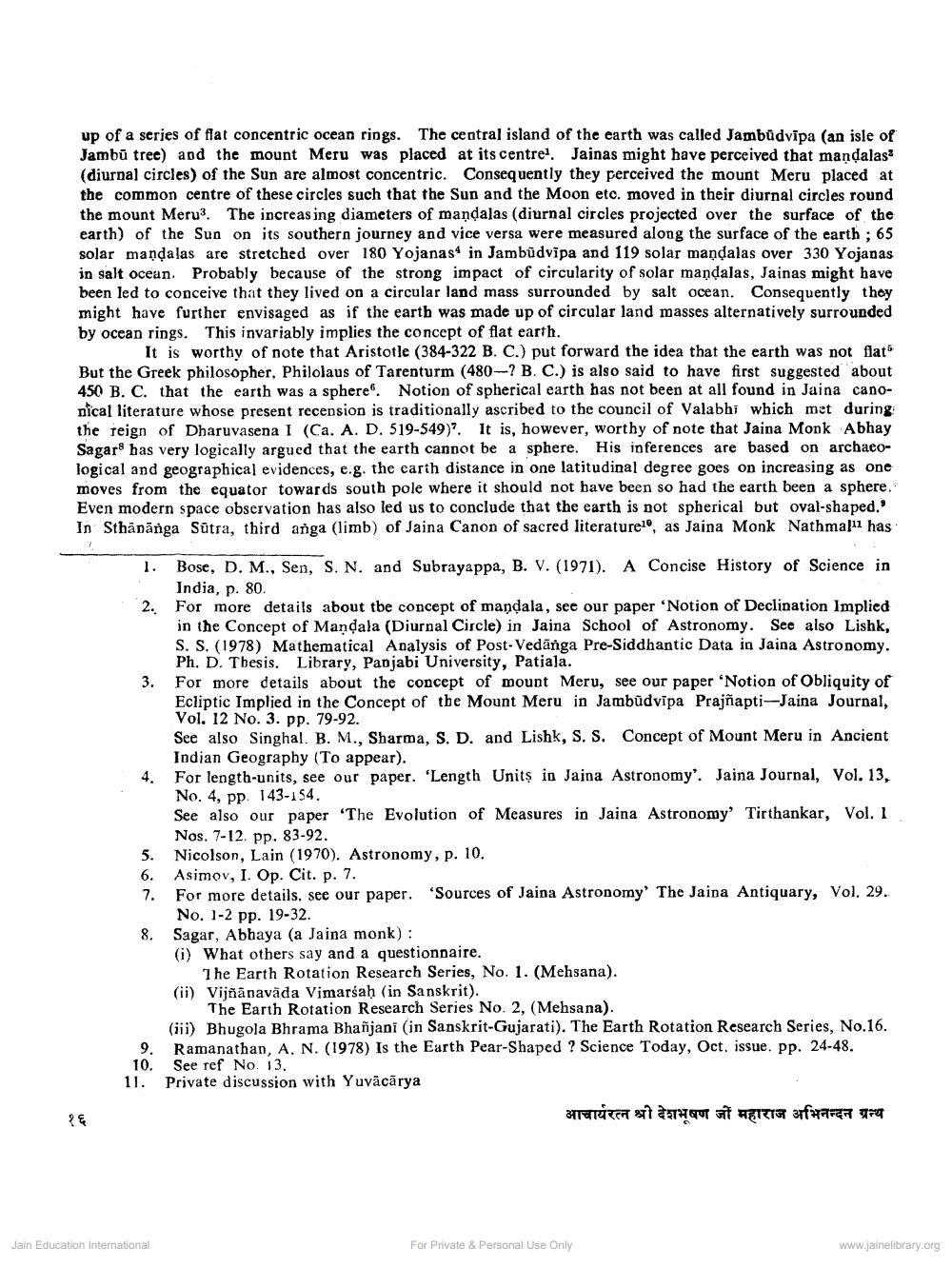________________
up of a series of flat concentric ocean rings. The central island of the earth was called Jambūdvipa (an isle of Jambū tree) and the mount Meru was placed at its centrel Jainas might have perceived that mandalas (diurnal circles) of the Sun are almost concentric. Consequently they perceived the mount Meru placed at the common centre of these circles such that the Sun and the Moon etc. moved in their diurnal circles round the mount Meru3. The increasing diameters of mandalas (diurnal circles projected over the surface of the earth) of the Sun on its southern journey and vice versa were measured along the surface of the earth; 65 solar mandalas are stretched over 180 Yojanas4 in Jambūdvipa and 119 solar mandalas over 330 Yojanas in salt ocean. Probably because of the strong impact of circularity of solar mandalas, Jainas might have been led to conceive that they lived on a circular land mass surrounded by salt ocean. Consequently they might have further envisaged as if the earth was made up of circular land masses alternatively surrounded by ocean rings. This invariably implies the concept of flat earth.
It is worthy of note that Aristotle (384-322 B. C.) put forward the idea that the earth was not flat But the Greek philosopher, Philolaus of Tarenturm (480-? B. C.) is also said to have first suggested about 450 B. C. that the earth was a sphere. Notion of spherical earth has not been at all found in Jaina canonical literature whose present recension is traditionally ascribed to the council of Valabhi which met during the reign of Dharuvasena I (Ca. A. D. 519-549). It is, however, worthy of note that Jajna Monk Abhay Sagar has very logically argued that the earth cannot be a sphere. His inferences are based on archacological and geographical evidences, e.g. the earth distance in one latitudinal degree goes on increasing as one moves from the equator towards south pole where it should not have been so had the earth been a sphere. Even modern space observation has also led us to conclude that the earth is not spherical but oval-shaped.' In Sthāpānga Sūtra, third anga (limb) of Jaina Canon of sacred literature, as Jaina Monk Nathmaļ12 has
1. Bose, D. M., Sen, S. N. and Subrayappa, B. V. (1971). A Concise History of Science in
India, p. 80. 2. For more details about tbe concept of mandala, see our paper Notion of Declination Implied
in the Concept of Mandala (Diurnal Circle) in Jaina School of Astronomy. See also Lishk, S. S. (1978) Mathematical Analysis of Post-Vedānga Pre-Siddhantic Data in Jaina Astronomy.
Ph. D. Thesis. Library, Panjabi University, Patiala. 3. For more details about the concept of mount Meru, see our paper 'Notion of Obliquity of
Ecliptic Implied in the Concept of the Mount Meru in Jambudvipa Prajñapti-Jaina Journal, Vol. 12 No. 3. pp. 79-92. See also Singhal. B. M., Sharma, S. D. and Lishk, S.S. Concept of Mount Meru in Ancient
Indian Geography (To appear). 4. For length-units, see our paper. 'Length Units in Jaina Astronomy'. Jaina Journal, Vol. 13,
No. 4, pp. 143-154. See also our paper 'The Evolution of Measures in Jaina Astronomy' Tirthankar, Vol. 1
Nos. 7-12. pp. 83-92. 5. Nicolson, Lain (1970). Astronomy, p. 10. 6. Asimov, I. Op. cit. p. 7. 7. For more details, see our paper. 'Sources of Jaina Astronomy' The Jaina Antiquary, Vol. 29.
No. 1-2 pp. 19-32. Sagar, Abhaya (a Jaina monk): (i) What others say and a questionnaire.
1 he Earth Rotation Research Series, No. 1. (Mehsana). (ii) Vijnanaväda Vimarśah (in Sanskrit).
The Earth Rotation Research Series No. 2, (Mehsana). (iii) Bhugola Bhrama Bhañjani (in Sanskrit-Gujarati). The Earth Rotation Research Series, No.16. 9. Ramanathan, A. N. (1978) Is the Earth Pear-Shaped ? Science Today, Oct. issue. pp. 24-48. 10. See ref No. 13. 11. Private discussion with Yuvācārya
आचार्यरत्न श्री देशभषण जी महाराज अभिनन्दन ग्रन्थ
Jain Education International
For Private & Personal Use Only
www.jainelibrary.org




